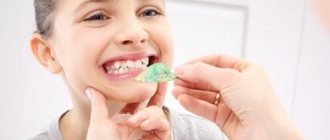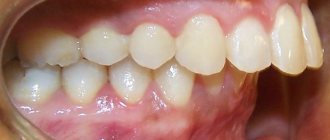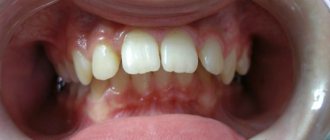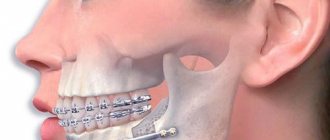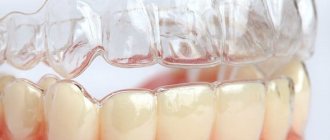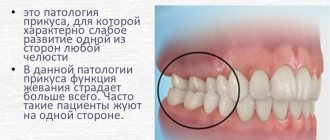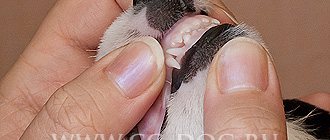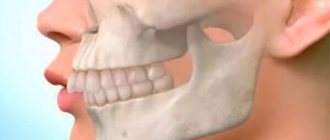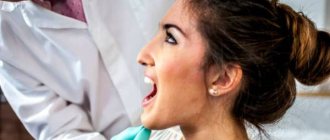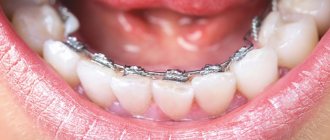10996
In dentistry, occlusion is the mutual position of the upper and lower dentition when the jaws are tightly closed. Almost all malocclusions entail serious, unpleasant and even dangerous consequences , which can only be avoided by undergoing orthodontic treatment on time. Moreover, problems can arise both in childhood and much later.
Overbite: what is it?
Bite (habitual occlusion) of teeth is a state of mutual contact of the upper and lower dentition with clenched jaws. There are different types of bites. Orthodontists distinguish between correct and incorrect teeth bites. If there are only permanent teeth in the mouth, then it is a permanent bite. If there are both permanent and baby teeth, then this is a temporary or removable bite.
From a functional point of view, a physiological (normal) and pathological version of occlusion or bite is distinguished. Correct and incorrect bites have characteristic features.
Correct bite: criteria and options
What is correct dental occlusion in humans? What is the correct bite?
What the bite should be like is determined by the orthodontist for each individual patient. Correct bite is a single complex of certain characteristics. Correct (physiological) bite has the following criteria:
- The entire dentition is dense, without gaps
- The upper teeth overlap the lower teeth by one quarter or a little more.
- The center of the face and the center of the dentition coincide
- The longitudinal inclination of the 6 front teeth on the upper and lower jaws is perpendicular to the line drawn between the pupils of the eyes.
Correct bite in a person, photo
The correct bite in a person has the following options:
Orthognathic occlusion
What does orthognathic bite mean? A person with an orthognathic bite has balanced dentition. This is an ideal bite that fully complies with the 4 above criteria and provides the most complete speech and chewing functions, as well as the most aesthetically pleasing.
Orthognathic dental occlusion in humans, photo
Straight bite
The same as orthognathic, but the incisors of the upper and lower jaws are in contact with each other, with the cutting edges facing each other. There is no overlap between the upper and lower incisors.
Direct bite in a person, photo
Biprognathic bite
Same as orthognathic, but the upper and lower incisors and canines have a pronounced slope forward towards the lips.
Biprognathic bite in humans, photo
Progenic bite
The same bite as orthognathic, but the inclination of the lower front incisors and canines is directed backward, due to a slight elongation of the lower jaw.
Progenic bite in humans, photo
All physiological types of occlusion ensure the normal functioning of the dentition during chewing. What a correct bite looks like can be seen in the examples of Hollywood actors. Which correct dental bite is best for each individual patient is determined after orthodontic diagnosis.
Correct bite, photo of a person
Diseases of the ENT organs
Disocclusion is accompanied by an atypical jaw structure, and some types, such as open bite, are accompanied by mouth breathing. This disrupts the normal functioning of the ENT organs. Such patients are prone to:
- sinusitis;
- sinusitis;
- tonsillitis;
- otitis
Patients with malocclusion are prone to respiratory diseases.
Therefore, it is important to correct the bite in childhood. Otherwise, ENT diseases will become chronic, and it will be almost impossible to get rid of them.
Incorrect pathological bite: types
When teeth are not properly closed in a state of habitual occlusion, malocclusion occurs.
Malocclusion of teeth in humans has the following types:
Deep (traumatic) bite
When closed, the upper teeth overlap the lower teeth by more than half. In this case, the cutting edges of the lower incisors can rest against the gum on the inside of the upper incisors and thereby injure it.
Deep bite of teeth in a person, photo
Low bite
In other words, this type of teeth occlusion occurs when teeth wear down and their height decreases due to bruxism, which leads to generalized wear of all upper and lower teeth and ultimately to underbite.
Low bite of teeth in humans, photo
Cross (scissor) bite
Occurs when the left or right part of the upper or lower jaw is underdeveloped. In a closed state, the rows of teeth overlap each other like scissors.
Crossbite of teeth in humans, photo
Medial (mesial, reverse) bite
It occurs when the size of the lower jaw increases, which protrudes forward in relation to the upper jaw. The incisors and canines of the lower jaw overlap the upper teeth.
Mesial occlusion of teeth in humans, photo
Distal (prognathic) bite
Occurs when the size of the upper jaw increases or when the lower jaw is underdeveloped. In this case, the lower incisors and canines do not contact the incisors of the upper jaw due to the fact that they are 0.5-1 cm behind the upper incisors and canines.
Mesial occlusion of teeth in humans, photo
Open bite
It occurs when some of the teeth do not fit together when the jaws are clenched. If the front teeth do not close together, a frontal open bite occurs; if the back teeth do not close, a lateral open bite occurs.
Open bite of teeth in a person, photo
Consequences
What is the danger of such an anomaly? You should know that improper closure of teeth can lead to the development of the following disorders in the body:
- Excessive stress on the teeth while chewing food. This leads not only to their early destruction, but also to their loosening and formation of gaps, which, in turn, threatens periodontal disease.
- Diseases of the temporomandibular joints. This complication develops gradually and, first of all, bothers a person with painful sensations and a kind of unpleasant clicking in the jaw when chewing, and headaches. Over time, the discomfort intensifies, in addition, facial features are distorted and teeth are destroyed.
- Disruption of normal breathing, as a result of which the patient experiences a frequent incidence of viral respiratory infections, sinusitis, and otitis.
- Diseases of the digestive system. Such pathologies develop due to the fact that with an incorrect bite, food is chewed poorly, and the organs of the gastrointestinal tract need to put more effort into chewing it.
- Difficulty brushing your teeth daily. As a result of inadequate implementation of this hygienic procedure, food debris accumulates in the cracks between the teeth, which leads to the development of caries.
- Complication of the restoration or prosthetics procedure.
Causes of bite pathology
Bite pathologies have a great variety of causes. There are congenital causes of malocclusion and acquired causes.
Congenital causes of malocclusion:
- Genetic defects transmitted in an autosomal dominant manner.
Most often this is due to the inheritance of abnormal jaw sizes and incorrect position of the jaws in relation to the base of the skull. Example: male representatives of the Habsburg dynasty in the Austro-Hungarian Empire for more than 200 years had a characteristic facial appearance with a strongly protruding chin, the so-called “heavy chin.”
- Intrauterine developmental disorder of the child.
This is associated with various pathologies of pregnancy, intrauterine infection, and metabolic disorders. This type of malocclusion is associated with jaw deformities and is extremely difficult to treat. As a rule, it is not possible to achieve complete rehabilitation of the patient without orthognathic surgery.
- Acquired causes of bite pathology.
After birth, the formation of occlusion is influenced by environmental factors. Such as birth trauma, duration of artificial feeding, pathology of the respiratory tract, bad habits of the child (thumb sucking, long sucking of the pacifier). Another reason is poor nutrition, multiple caries of baby teeth, and endocrine diseases.
In adult patients, malocclusion is associated with tooth extraction and the occurrence of dentition defects, which are not compensated in time by bridges or implants.
Pathology at the shifting stage of formation
The period of replacement teeth is the most significant for the formation of a correct bite. Abnormal development of the dentofacial apparatus in this case can lead to the following complications:
- underdevelopment of the temporomandibular apparatus , which subsequently provokes serious diseases of the ENT organs and pathologies of the cervical spine;
- facial asymmetry;
- decrease in the quality of dental tissues , contributing to the development of dental diseases that lead to their premature loss.
Change in appearance after treatment
Abnormal development of occlusion is a pathology that develops from childhood. Lack of proper attention to this process leads to serious consequences that are often difficult to stop.
Prevention of this pathology will preserve the health of not only teeth, but also all body systems.
And in this video, a specialist expresses his opinion:
If you find an error, please select a piece of text and press Ctrl+Enter.
Tags distal bite correction of bite malocclusion orthodontics consequences of malocclusion
Did you like the article? stay tuned
Bite pathology: consequences
The consequences of various malocclusion pathologies for the dental system and for the entire body are very severe. In the dental system, the load on the mandibular joint increases, the masticatory muscles are overloaded, generalized abrasion of teeth occurs with a decrease in the height of the bite, the frequency of inflammatory diseases of the oral mucosa increases, with a deep bite the gums in the area of the upper incisors are often injured.
For the body, damage from a pathological bite consists of impaired swallowing, chewing, and biting food. The nasopharynx and respiratory tract are susceptible to more frequent diseases, and breathing worsens.
In addition, crooked teeth disfigure the smile and reduce attractiveness. This leads to psychological complexes and interferes with communication with others.
Diseases of the gastrointestinal tract
One of the key health consequences of disocclusion is digestive disorders. Since complete primary processing of food is impossible, increased work of the gastrointestinal tract is required. This contributes to the development of:
- gastritis;
- heartburn;
- reflux esophagitis – reflux of stomach contents into the esophagus;
- colitis;
- problems with bowel movements;
- enterocolitis.
Inadequate chewing of food provokes the development of gastrointestinal diseases.
Important! Inadequate chewing also reduces the digestibility of food and leads to a lack of useful elements and vitamins in the body.
Prevention of malocclusion
Prevention of malocclusion can be divided into the following periods:
- Before the baby is born.
Proper nutrition is essential during pregnancy. From the twentieth week of pregnancy, the mineralization of tooth germs in the fetus begins, so a balanced intake of calcium and phosphorus is required.
- After the birth of the child.
Feeding a child must be correct. In an infant, before the growth of the facial skeleton is complete, the lower jaw is shorter than the upper jaw. The growth of the lower jaw is ensured by muscles that push and pull the lower jaw during sucking. If there is a large hole in the bottle nipple and the child does not suck out the milk, but swallows, the muscles do not work, and the lower jaw does not grow. A distal malocclusion is formed. Therefore, when artificial feeding, the hole in the nipple should be small.
If there are problems with nasal breathing, the child breathes through the mouth. The tongue moves in the oral cavity. As a result, the child’s mouth is slightly open, and the growth of the upper jaw changes. Thus, a narrowing of the palate and upper dentition occurs. An open bite is formed.
In a 2-4 year old child, during the formation of baby teeth, it is necessary to control bad habits, such as thumb sucking and pacifiers. It is also necessary to accustom your child to oral hygiene. This will save baby teeth from caries and from early removal. The preservation of baby teeth is the key to timely and correct eruption of permanent teeth and the formation of a correct bite.
- Prevention of dental malocclusion in adults.
After 14-15 years, a permanent bite is formed. From this time on, any loss of teeth leads to deformation of the dentition, and as a result, to malocclusion. Therefore, prosthetics of dental defects or orthodontic treatment cannot be postponed for a long time.
Reasons for appearance
The main causes of malocclusion are the presence of the following pathologies. These include:
- genetic predisposition of the organism. This is due to the presence of an incorrect position of the jaw in one of the parents;
- injury to one of the jaws;
- lack of calcium in the diet;
- long-term breastfeeding;
- frequent sucking of pacifiers and bottles;
- softness of bones.
In infancy, it is recommended to monitor the child's nutrition. There should be mixtures based on natural goat or cow milk. The liquid must contain a maximum concentration of Ca. This will help reduce the risk of this type of pathology.
In preschool age, incorrect posture can cause curvature of the spinal column, which will also affect the condition of the jaw and occipital region. Here it is important to diagnose the course of the pathological process in a timely manner.
The appearance of malocclusion is directly associated with frequent colds and viral diseases. A harmful infection can cause softening of the bones, which is accompanied by curvature of the bone elements.
How to determine bite?
An accurate diagnosis and determination of the bite is carried out by an orthodontist. If only dental deformation is detected in the oral cavity, then there may be no external signs indicating orthodontic problems. In the case when jaw anomalies are added to the deformation of the dentition, the problems, as they say, are “in the face” and are noticeable to others.
This is either a massive chin protruding forward or, conversely, an underdeveloped chin and a sloping lower third of the face. Also noticeable is the protruding upper lip, which is unable to cover the upper incisors tilted like a fan forward. When smiling, asymmetry of the upper teeth or longitudinal axes of the teeth tilted to the side may be noticeable. If such problems exist, orthodontic treatment is necessary.
Depending on the specific problem, correcting a bite in adults can take one to three years. For severe maxillofacial deformities, orthodontic treatment with orthognathic surgery can help.
The sooner the bite problem is resolved, the fewer complications may arise.
Pathological temporary
The development of an abnormal temporary (deciduous) bite in children is often triggered by hereditary factors or the pathological course of a woman’s pregnancy.
It is important to prevent problems in a child at the initial stages of development. The main consequences of the clinical situation include:
- development of pathological permanent dentition ;
- speech distortion;
- diseases of the respiratory tract and nasopharynx;
- development of chronic adenoiditis;
- aesthetics and psychological problems in adolescence.
Today, there are special orthodontic structures to correct the bite of even the youngest patients.
Malocclusion almost always affects the growth of permanent teeth.
